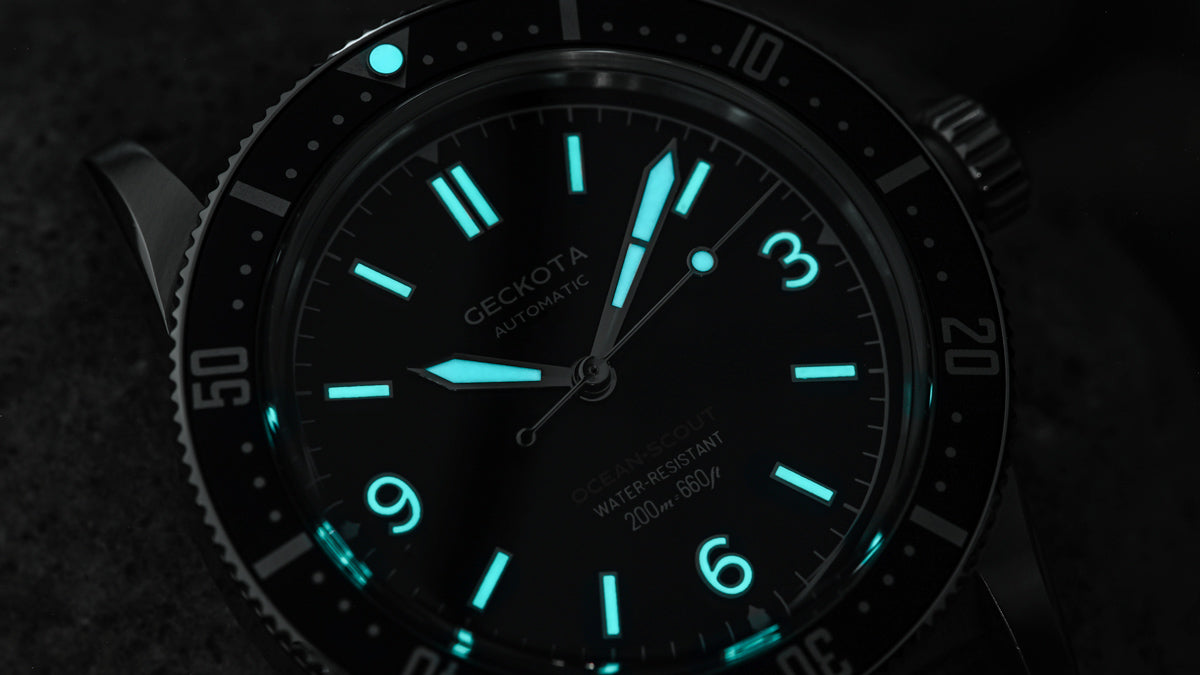
January 22, 2024 4 min read
There are some technical features that although small, can make a really big difference to the overall look and functionality of a timepiece. One of them is lume, otherwise known as luminous or luminescent markers.
From dive watches to pilot’s watches, tactical field watches to even sometimes classy dress watches, lume used on watch dials and bezels has evolved into more than just a cool feature, but an essential part of a design’s functionality. For those of you new to the world of watches, today we’ll be uncovering all the secrets behind this mesmerising substance and exploring the various types of luminescent materials used on watches.
 Geckota Ocean-Scout Lume Shot - Credit Geckota
Geckota Ocean-Scout Lume Shot - Credit Geckota
First things first, what are we talking about when we say lume? Lume, short for luminescence, refers to the glow-in-the-dark material applied to watch dials, hands, and sometimes other elements on a timepiece. The primary purpose of lume is to make the watch readable in low-light or dark conditions. This is especially crucial for individuals who rely on their watches in situations where visibility is compromised, such as underwater or in the dim lighting of a cockpit.
Lume has become something of a staple in many modern-day watches due to the many benefits it brings. Lume allows the watch to remain visible and readable in the dark. This is particularly important for dive watches, pilot watches, and any timepiece designed for use in environments where natural or ambient light is limited.
 Geckota Ocean-Scout Lume Shot - Credit Geckota
Geckota Ocean-Scout Lume Shot - Credit Geckota
For divers, lume is a safety feature that facilitates timekeeping underwater. It allows divers to read their watches in the depths where sunlight doesn't penetrate. Similarly, for pilots or individuals engaged in activities where precise timing is crucial, luminescent coating ensures that time can be quickly and accurately read.
Beyond its functional aspects, lume has become a fun design element, adding a captivating and distinctive aesthetic to watches. Different watch brands may use various colours and application styles for their luminescence, contributing to the overall visual identity of a timepiece.
 Fortis Lume - Credit WatchGecko
Fortis Lume - Credit WatchGecko
Luminescence in watchmaking has come a long way since its initial introduction. The technology was first used at the end of World War I when military personnel required an easier way to read their wristwatches and pocket watches while undergoing their duties.
The first type of lume created was radium paint, a radioactive metal that naturally emits a luminescent glow. Radium was discovered in 1908 and shortly after, watchmakers seized an opportunity to utilise its properties by applying it as paint on the hands and markers of watches during the early 20th century.
However, as we know now, radium paint comes with a broad set of issues. Radium is radioactive and highly hazardous to human health. Even minimal contact with radium paint, as worn on a watch, can have detrimental effects to someone’s overall well-being. Eventually, radium was banned from watchmaking in 1968.
 Luminox Lume - Credit WatchGecko
Luminox Lume - Credit WatchGecko
For a while, promethium was used as a substitute for luminescence on watches but due to its rarity and lifespan of around two years, it was quickly replaced by tritium. Tritium is a radioactive isotope of hydrogen and is still used by many watchmakers today. It is valued for its ability to emit a continuous glow without requiring any exposure to light, unlike non-radioactive luminescent materials.
The first luminescent substance to be used in watchmaking that wasn’t radioactive was LumiNova which was created during the 1940’s. It is a phosphorescent pigment that needs to be charged by light before glowing in the dark. Eventually, a Swiss company mass-produced their own LumiNova variant and named it Super-LumiNova, the most commonly used lume on watches today, and arguably one of the best.
 Omega Seamaster Lume - Credit WatchGecko
Omega Seamaster Lume - Credit WatchGecko
Most high-quality watches these days, especially those in the field, dive and pilots categories, are adorned with Swiss Super-LumiNova. The photoluminescent material is best-known for its exceptional glow in the dark properties, but it is also not radioactive distinguishing it from the previously mentioned luminescent materials like radium and tritium.
Since it is a phosphorescent material, Super-LumiNova absorbs and stores light energy when exposed to natural or artificial light sources. Once the light source is removed, Super-LumiNova releases this stored energy as visible light, producing a glow in low-light or dark conditions. It has an extended glow duration and typically can glow continuously for up to 15 hours before requiring further exposure to light.
Super-LumiNova is also available in various colours, from greens, pinks, blues, purples and yellows, allowing watchmakers to customise the luminescent elements on a watch. This versatility contributes to a wide range of aesthetic design possibilities in watchmaking and has resulted in some really cool colour combinations.
Finally, there are several quality gradings of Super-LumiNova available: Standard Grade, Grade A and Grade X1. The latter is the most recently developed and is considered to be the longest and brightest performing.
So, there you have it, all there is to know about lume in watchmaking. Whether you are searching for a glow-in-the-dark watch for functional purposes or you simply enjoy the childlike sense of wonder these colourful, luminous timepieces bring, check out our range of lume watches here at Geckota. We have a huge range of models applied with Swiss Super-LumiNova for exceptional legibility and design.

About the Author: Jon Quinn
About the Author: Jon Quinn
I’m Jonathan Quinn, founder and owner of Geckota. What excites me is what excited me when I started the business – offering high-quality watches and straps that I couldn’t find elsewhere, and seeing the pleasure they give our customers around the world.
More Articles by Jon Quinn